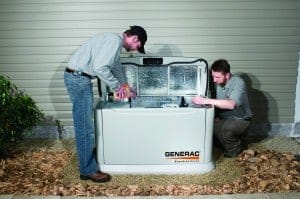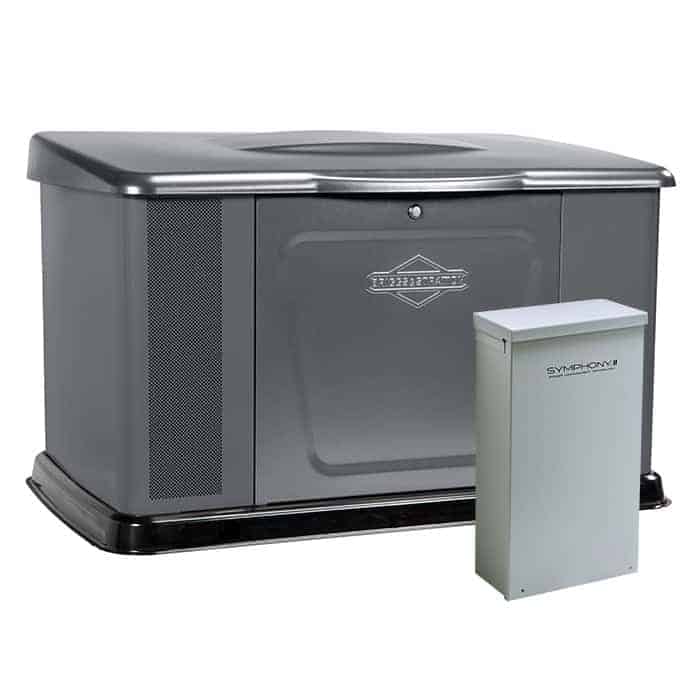Most of us know that regular maintenance keeps our cars in tip-top condition. We change the oil, oil filters and air filters. Periodic tune ups replace items like spark plugs, spark plug wires, and other parts that wear out over time. Car manufacturers specify specific maintenance intervals for almost every aspect of an automobile.
Generator engines also require maintenance on regular schedule. Manufacturers specify the interval schedule for most items in hours. Some items require annual or semiannual maintenance. Just like an automobile, on-time maintenance for a standby generator or portable generator contributes to longevity and keeps your generator ready for the next power emergency or weekend camping trip.
Your owner manual lists the required maintenance periods for anything that requires periodic replacement or adjustment.
Standby Generator Maintenance and Upkeep
Maintenance Schedules

Check your generator owners manual and you might be surprised by how frequently it requires maintenance. Most generator engines are air cooled, which means they run hotter, burn oil faster, and the spark plug electrodes erode sooner.
A car engine might require an oil change after 3000 miles under severe driving conditions which could be as little as 55 hours of highway driving. Standby generator engines require maintenance every 100 or 200 hours, or every 4 to 8 days. Most manufactures advise owners to stop the generator once a day and let it cool for five minutes, then check and top off the oil as necessary.
Portable generators usually have an even shorter maintenance cycle. Daily oil checks are necessary. Shut the generator down, let it cool for five minutes, and check the oil. Top off as required. Portable Generator oil and filter changes are required every 25 to 100 hours, depending on the model and manufacturer.
If you don’t use the portable or standby generator other than periodic exercise cycles, Change the oil at least every two years or one year according to the manual.
In climates where summers are warm and winters are very cold, you may need different oils for winter and summer operation. Check your owner manual.
How to Use a Portable Generator for Home Backup
Regular Maintenance
Read your owners manual for specifics on performing maintenance on your generator.
Safety First: Always disconnect electrical loads (anything currently using power) from the generator before you turn it off. Never try to perform maintenance with a load connected or while the generator is running. Ensure the generator cannot start and will not attempt to start while you perform maintenance. On a standby, this often requires the removal of a fuse.
Check the oil level on standby generators every 24 hours of use, or once a month when not using the generator. On portables, check whenever you add fuel to the unit. If the oil level is below the full mark on the dipstick, add just enough oil bring the level up to the full mark, but don’t overfill.
FEMA Recommends a Generator for Emergencies
To change the oil, remove the drain plug and allow the oil to drain into a container. After the oil reservoir is empty, remove the oil filter and replace it with a new one. Replace the drain plug and fill the engine with the required amount of oil to reach the full mark on the dip stick. Be sure to use the correct oil viscosity for your region, based on local temperatures.
Access the air filter by removing it’s housing or cover. Take the time to clean the area around the air filter and replace it with a new one. Check the air intakes in the generator case and clear away any debris such as leaves or grass.
Top off unsealed battery fluid levels with distilled water and check the condition with a hydrometer. Clean and tighten the battery connections as necessary.
Remove old spark plugs with a spark-plug wrench. Check the gap on the new plugs with a spark-plug gauge and adjust if necessary before installing the new plugs.
Generators without hydraulic lifters need occasional valve adjustments.
If changing fluids, filters and plugs or adjusting valves is not for you, find a Local Generator Maintenance Service Company to perform the maintenance for you. Some Generator Installers offer service contracts for maintenance and repairs. You can even configure your generator to inform your service rep when it needs maintenance.
Natural Gas Generators for the Whole House
Be Ready for Maintenance
You never know when the need to run your generator for an extended period of time will happen. Keep a supply of oil on hand to replenish the reservoir as required.
Maintenance kits from Norwall make buying parts easier than sourcing them separately, and you won’t worry about finding the correct parts when you need them. It is a good idea to keep several kits on hand for use during extended power outages.
Whether through regular exercise cycles or the occasional short-term outage, the hours can stack up quickly. If you’re getting close to time when maintenance is needed, don’t wait. Service your generator and be ready when the next outage leaves your neighborhood without power.
Best Portable Generator for Home Use
Updated December 8, 2021



















